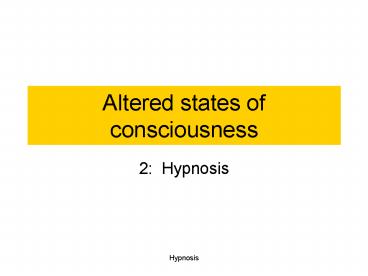Altered states of consciousness - PowerPoint PPT Presentation
1 / 20
Title:
Altered states of consciousness
Description:
Mesmerism: Franz Anton Mesmer 1734-1815. Studied medicine at University of Vienna ... medics such as James Esdaile, operations conducted using hypnosis as anaesthesia ... – PowerPoint PPT presentation
Number of Views:23
Avg rating:3.0/5.0
Title: Altered states of consciousness
1
Altered states of consciousness
- 2 Hypnosis
2
Hypnosis
- This is an example of stage hypnotism
- What is going on here?
- Are the subjects asleep?
- Do they know what they are doing?
- Is this an ASC?
3
Hypnosis the history
- Mesmerism Franz Anton Mesmer 1734-1815
- Studied medicine at University of Vienna
- Interested in the influence of the planets on the
human body
4
Animal magnetism
- The language of the times Newtons certain
subtle spirit' which pervades material bodies and
is a force for attraction. Newton also writes of
'electric and elastic spirit'. - Mesmer termed his effect 'animal gravitation'
this later became 'animal magnetism'. He believed
that when the ebb and flow of this magnetic fluid
within a human was out of harmony with the
universal rhythm psychosomatic illness could
result.
5
Franzl Oesterlin
- Francisca Oesterlin 20yrs stayed with Mesmers
during 1770s- acted as critical patient for
Mesmer like Anna O for Breuer/Freud. - Symptoms hysterical fever, convulsions,
vomiting, inflammation of intestines, inability
to urinate, toothache, earache, despondency,
hallucinations, trance, fainting, temp.
blindness, feelings of suffocation, attacks of
paralysis - Mesmer observed her attacks and decided it was
the ebb and flow of universal fluid or animal
gravitation that was the cause
6
The treatment of Osterlin
- Mesmer used magnets to control the flow of the
fluid with startling results - It was on July 1774, that my patient having
suffered another of her attacks, I placed three
magnets on her, one on the stomach and one on
each leg. Almost immediately she began to show
severe symptoms. She felt painful volatile
currents moving within her body. After a
confused effort to find a direction, they flowed
downward to her extremities. Alleviation
followed and lasted for six hours. A repetition
of the attack on the following day caused me to
repeat the experiment with the same success
7
Universal fluid
- Mesmer became convinced he could alter the tides
of the universal fluid and mapped these out on an
anatomical chart - Balance of animal magnetism is needed
- Materials other than magnets could be used e.g.
wood - Mesmer realised that his touch could act in the
same way
8
Mesmers techniques
- The Baquet a magnetized tub
- Patients would hold the metal bars and animal
magnetism would be conducted through them - Objects could store up the universal fluid
9
Conclusions about Mesmerism
- Energetic exchange (some kind of subtle energy
which is involved in illness/health idea
existent in oriental medicine) - Placebo (a psycho-social influenceEstimates of
the placebo effect) - Altered state of consciousness (hypnosis as a
true ASC) - Fraud
10
Development of Hypnosis
- Mesmer was subject of royal commission
investigation-generally discredited - The trance/sleep aspects were taken on by other
medics such as James Esdaile, operations
conducted using hypnosis as anaesthesia - Hypnosis adopted by depth psychologists following
Charcot, Freud etc.
11
Hypnosis today
12
State or no-state
- Arguments over whether simulation of hypnosis can
produce same phenomena or not as hypnosis - Orne noted that that there are differences in
emotions experienced by true hypnotics and
simulators - Hilgard argues for a special kind of logic
displayed in hypnotic state
13
Is someone hypnotised?
- Very relaxed state
- Rational/logical faculties suspended (replaced by
trance logic) oriented towards blurring of
self/other boundaries - Physiological changes can happen as a result,
e.g. blood flow to injuries can be reduced
(suggests psycho-somatic interplay)
14
Hypnosis as ASC
- Phenomena Amnesia, Analgesia, Hyperamnesia
(recall of forgotten experiences), Feats of
dexterity and strength, hallucinations, post
hypnotic effects (response to some cue often some
time after the suggestion was given). - Suggests different concept of mind and again high
interaction with physiological processes
15
Is someone hypnotised?
- Reality is to some degree mediated by the
instructions of the hypnotist (because the usual
critical faculties are dissociated) - In very hypnotisable subjects the body acts as if
the suggestion is true, e.g. burns - Hypnotic depth is based upon the degree to which
the subject responds, from partial sensorimotor
response to full blown sonambulism
16
What can hypnosis do?
- Pain reduction stronger than placebo, anxiety
reducing effect, can still be felt by hidden
observer, hypnosis stronger than waking
suggestion, possible brain changes noted in
relation to hypnosis compared to simulation - Injury and disease relief Ichthyosis, warts,
reduced blood flow in injury and surgery,
suggestions of burns, skin complaints
17
What can hypnosis do?
- Changes in bodily structure breast development,
skin inflammation, skin temperature differences,
modulation of gastric acid secretion - Improvements of performance cognition and
learning, physical performance strength and motor
skills - Negative effects most linked with stage
hypnotists, but some with research studies,
headache, stiff neck, cognitive distortion or
confusion
18
In general
- Deep absorption leads to exceptional functioning
- Anxiety, pain, and physiological processes can be
modified - Creativity processes correlate with hypnotic
responsiveness - Hypnotic responsiveness can be cultivated
- Hypnotic virtuosos develop by practice
- Social influence on human capacities
19
Hypnosis as anomaly
- Points to a different aspect of mind
(rational/logical is base measure in our culture) - Antagonism to reduction of free will and volition
in our culture, need for control - Unknown mediators trance, animal magnetism,
difficulties of measurement - Points to an embodied mind which psychology
largely hasnt tackled yet
20
Extra reading
- Kirsch, I and Lynn, S. J. (1998)
Social-Cognitive Alternative to Dissociation
Theories of Hypnotic Involuntariness. Review of
General Psychology, 2, 1, 66-80. - Kirsch, I. and Lynn, S. J. (1998) Dissociation
Theories of Hypnosis. Psychological Bulletin,
123, 1, 100-115.

